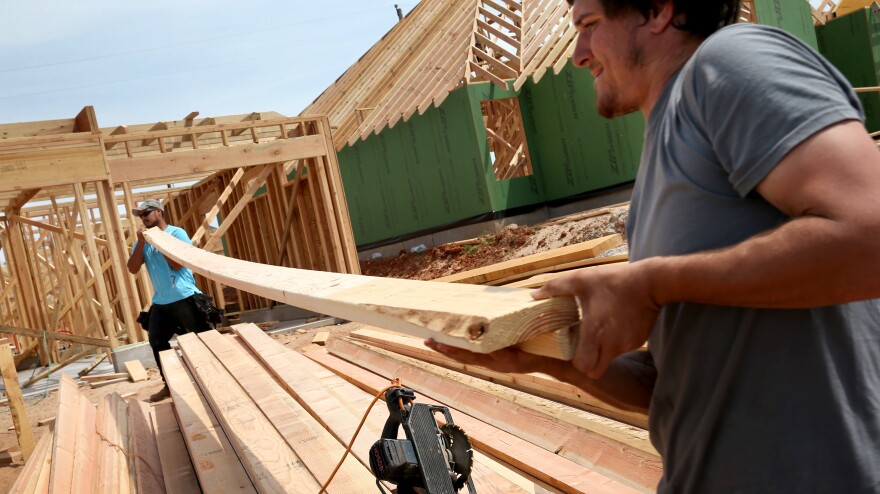One year ago Tuesday, a violent tornado obliterated the city of Moore, Okla., killing 24 residents and leaving nearly 400 injured among the razed homes and businesses. It was the third violent tornado to strike the city in the past 15 years. But rather than move away, residents have stayed put in Moore — and more and more are actually moving here.
Greg Blalock, who has lived in Moore for more than 20 years, experienced the devastation of last year's tornado firsthand. Blalock was out of town when it hit, and his wife was safely sheltered. But the tornado destroyed their house. When he returned that night, the couple joined hundreds of neighbors and left the area, along with their dog and a few salvaged possessions in a suitcase.
As soon as he could get his lot cleared, Blalock rebuilt. "If you move somewhere else — if you're anywhere around in here, which I would have to be because of my business — you're apt to get hit by a tornado. That's all there is to it."
And he's right. According to the National Weather Service, the city has averaged a tornado every 2 1/2 years since 1991.

So why would anyone new move here? Well, it's hard to argue with economics. Moore is close to Oklahoma City, a growing job market. The town has highly rated schools, and the median price for a house is $125,000. Over the past decade-and-a-half, the population has grown 30 percent.
When the storm hit last year, Deidre Ebrey, Moore's director of economic development, was at a conference trying to recruit businesses to come to the town.
"I'm sitting at a table with brokers representing Starbucks and Chipotle," Ebrey says. "Then I'm watching the monitors in the food court and I'm like, 'I have to go.' "
Ebrey's home was not destroyed, but she wondered if the businesses would still come. After the tornado, one of the first calls she made was to Amy Nolen, the building project director for a pharmacy service company called Computer-Rx. The company had been planning to build its headquarters in Moore, and Ebrey was afraid the company had changed its mind after the storm.
But Nolen eased her fears. "We never really thought of not moving over there," Nolen says. "Our first thought was, 'What can we do to keep our employees safe?' And so we've decided the warehouse will be a FEMA-rated safe room."
Construction of the new Computer-Rx headquarters is now underway. Other retailers, including the health club chain LA Fitness and mobile carrier Sprint, have also moved forward with pre-existing plans to open up shop in Moore. Fields that were empty before the storm are now filling up with new eateries, like Starbucks.
"At no time was it part of our discussion that we wouldn't continue to support [the community] as it continues to rebuild," says Traci York, a regional vice president at Starbucks.
And Moore isn't just rebuilding; it's also drawing new residents. According to the city, at least 375 new homes have been built since the tornado, in addition to the 1,100 that are being rebuilt.
Celina Chambers settled in town just five months after the tornado. She says friends elsewhere have repeatedly asked her why she would move to Moore.
"My answer to them was, 'Why wouldn't I move?' I mean, I saw some things down here after the tornado that I'd never witnessed before," Chambers says. "Never once did I see somebody [say], "Oh, why me?' or, 'Why us?' or waiting for somebody else to come do something."
It's not just the spirit of the community that appeals to Chambers. She also travels a lot for her job, and Moore has easy access to both the interstate and the Oklahoma City airport. Plus, it's closer to family, she says. If disaster strikes again, Chambers is certain that this community would help her recover; they've done it before, and they'll do it again.
Copyright 2014 KOSU




